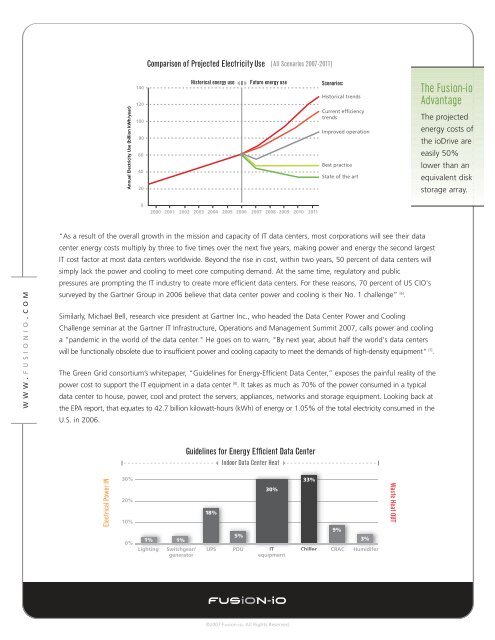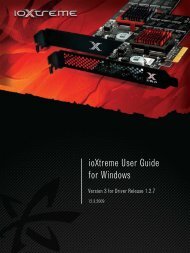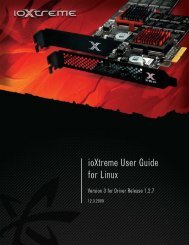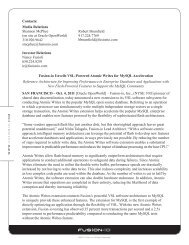Taming the Power Hungry Data Center - Fusion-io
Taming the Power Hungry Data Center - Fusion-io
Taming the Power Hungry Data Center - Fusion-io
You also want an ePaper? Increase the reach of your titles
YUMPU automatically turns print PDFs into web optimized ePapers that Google loves.
Comparison of Projected Electricity Use [All Scenar<strong>io</strong>s 2007-2011]<br />
Annual Electricity Use (bill<strong>io</strong>n kWh/year)<br />
140<br />
120<br />
100<br />
80<br />
60<br />
40<br />
20<br />
Historical energy use Future energy use Scenar<strong>io</strong>s:<br />
Historical trends<br />
Current efficiency<br />
trends<br />
Improved operat<strong>io</strong>n<br />
Best practice<br />
State of <strong>the</strong> art<br />
The <strong>Fus<strong>io</strong>n</strong>-<strong>io</strong><br />
Advantage<br />
The projected<br />
energy costs of<br />
<strong>the</strong> <strong>io</strong>Drive are<br />
easily 50%<br />
lower than an<br />
equivalent disk<br />
storage array.<br />
0<br />
2000 2001 2002 2003 2004 2005 2006 2007 2008 2009 2010 2011<br />
WWW. FUSIONIO. COM<br />
“As a result of <strong>the</strong> overall growth in <strong>the</strong> miss<strong>io</strong>n and capacity of IT data centers, most corporat<strong>io</strong>ns will see <strong>the</strong>ir data<br />
center energy costs multiply by three to five times over <strong>the</strong> next five years, making power and energy <strong>the</strong> second largest<br />
IT cost factor at most data centers worldwide. Beyond <strong>the</strong> rise in cost, within two years, 50 percent of data centers will<br />
simply lack <strong>the</strong> power and cooling to meet core computing demand. At <strong>the</strong> same time, regulatory and public<br />
pressures are prompting <strong>the</strong> IT industry to create more efficient data centers. For <strong>the</strong>se reasons, 70 percent of US CIO's<br />
surveyed by <strong>the</strong> Gartner Group in 2006 believe that data center power and cooling is <strong>the</strong>ir No. 1 challenge” [6] .<br />
Similarly, Michael Bell, research vice president at Gartner Inc., who headed <strong>the</strong> <strong>Data</strong> <strong>Center</strong> <strong>Power</strong> and Cooling<br />
Challenge seminar at <strong>the</strong> Gartner IT Infrastructure, Operat<strong>io</strong>ns and Management Summit 2007, calls power and cooling<br />
a "pandemic in <strong>the</strong> world of <strong>the</strong> data center." He goes on to warn, "By next year, about half <strong>the</strong> world's data centers<br />
will be funct<strong>io</strong>nally obsolete due to insufficient power and cooling capacity to meet <strong>the</strong> demands of high-density equipment" [7] .<br />
The Green Grid consortium’s whitepaper, “Guidelines for Energy-Efficient <strong>Data</strong> <strong>Center</strong>,” exposes <strong>the</strong> painful reality of <strong>the</strong><br />
power cost to support <strong>the</strong> IT equipment in a data center [8] . It takes as much as 70% of <strong>the</strong> power consumed in a typical<br />
data center to house, power, cool and protect <strong>the</strong> servers, appliances, networks and storage equipment. Looking back at<br />
<strong>the</strong> EPA report, that equates to 42.7 bill<strong>io</strong>n kilowatt-hours (kWh) of energy or 1.05% of <strong>the</strong> total electricity consumed in <strong>the</strong><br />
U.S. in 2006.<br />
Guidelines for Energy Efficient <strong>Data</strong> <strong>Center</strong><br />
Indoor <strong>Data</strong> <strong>Center</strong> Heat<br />
Electrical <strong>Power</strong> IN<br />
30%<br />
20%<br />
10%<br />
0%<br />
1%<br />
Lighting<br />
1%<br />
Switchgear/<br />
generator<br />
18%<br />
UPS<br />
5%<br />
PDU<br />
30%<br />
IT<br />
equipment<br />
33%<br />
Chiller<br />
ler<br />
9%<br />
CRAC<br />
3%<br />
Humidifer<br />
Waste Heat OUT<br />
©2007 <strong>Fus<strong>io</strong>n</strong>-<strong>io</strong>, All Rights Reserved.















